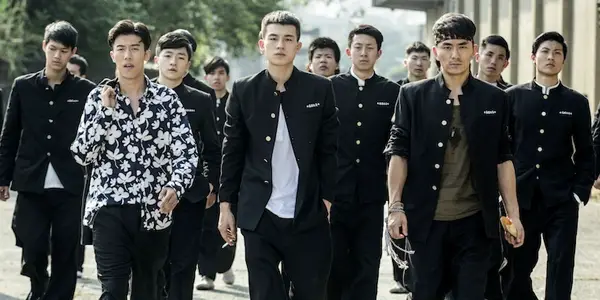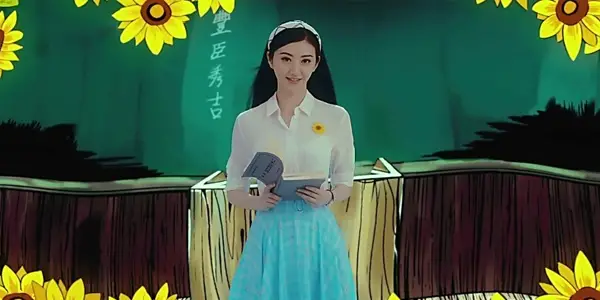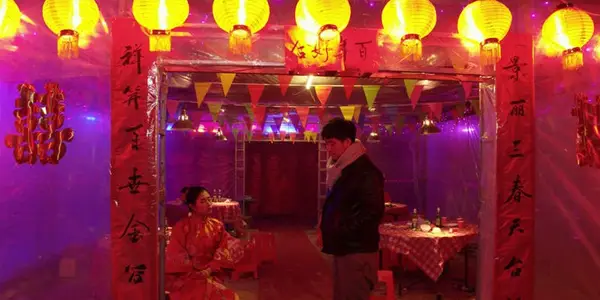The Golden Koala Chinese Film Festival 2018 Report

Alex is a 28 year-old West Australian who has a…
The Golden Koala Chinese Film Festival is currently one of the biggest and most influential overseas Chinese film events, one which is organised by the Chinese Film Incorporated (CFFI). Touring Australia for the last couple of months, the festival is a great chance to exhibit some of the upcoming titles emerging from the booming cinematic market, with a mixture of high-profile films and some undiscovered independent projects to give a nice variety to the occasion.
This past weekend, I managed to catch two diverse features: Jiang Zhuoyuan’s Fist & Faith and Xiaodong Liu’s Interval, a memorable pairing that were both engaging for separate reasons.
Fist & Faith (Jiang Zhuoyuan)

Don’t be put off by the title of Zhuoyuan Jiang’s debut feature Fist & Faith, this isn’t a religious UFC-themed movie starring Sam Worthington, but actually an action-packed Chinese schoolyard romp that matches its violent brutality with a surprising amount of pathos. For those who fell in love with the video-game infused aesthetics of Edgar Wright’s Scott Pilgrim VS the World will find plenty to love here, as Fist & Faith is as equally energetic and accompanied with an array of similar on-screen graphics to display its manga-inspired style. These elements that emphasise its manga influence (Japanese comics) include framing the action within comic book panels, adding speedlines and speech bubbles to accentuate sound effects and just a general sense of endearing exaggeration.
Introduced through a stylish animated presentation, the young narrator ‘Ah Fart’ (a disparaging nickname given after a poorly-timed release of gas in class) recounts the state of 1930’s China, then known as the Japanese-owned puppet state of ‘Manchukuo’, a country that was struggling to maintain its social identity against the oppressive Imperial Army. Due to the Japanese aggressively erasing Chinese literature and culture through violent means, rebellious groups of underground reading began to appear, pockets of passionate citizens that learned to fight back by keeping the art of the written word alive, or as one of their leaders states “helping identify Chinese people and win the war”.
This political struggle is boiled down into the microcosm of one Chinese high school, a place that has just established a shaky truce between its Chinese and Japanese student factions. This isn’t any ordinary schoolyard, it’s more an arena where blood is the currency of survival, and teachers are never to be seen. Ah Fart (Guansen Ding) is the right hand man to Jing Hao (Hao Ou), the leader of the Chinese pupils, who has just fallen in love with the newest teacher at the school, the angelic Liu He (Jian Tin, recently seen in this year’s Pacific Rim Uprising).
With Jing Hao being head over heels (literally) with the bike-riding educator, his main rival, Shibata (Kento Hayashi), the head of the opposing Japanese teenagers, is given a dangerous proposal – due to international pressures, the Japanese Imperial army cannot attack reading groups anymore, so leading Army Officer Matsui recruits the impressionable Shibata to have his gang personally wipe out the defiant revolutionaries, because as Matsui points out “it’ll just be more violence between the students”.

In order to restore his family’s fallen honor (an aspect that never quite gets explained), Shibata is quick to violently take down these hidden clubs, that is, until he targets one headed by Liu He, which forces the love-struck Jian to step in and defend his crush, erupting a war between the conflicting clans that escalates into some very impressive large scale multi-men brawls. These sequences closely resemble Takashi Miike’s Crows Zero, but luckily, Jiang’s script, co-written with Feifei Gu, has much more on his mind than just mindless bloodshed, even when these hand-to-hand clashes are executed with a similar flair of definitive Zach Snyder characteristics (such as his infamous speed-up/slow-down style of slow motion fighting that Patty Jenkins imitated in Wonder Woman).
Like John Woo’s highly underrated Bullet to the Head, Fist & Faith starts off pretty innocently, building our main characters within the prism of a goofy but like-able comedy, before descending into much darker territory. Unlike most Quentin Tarantino rip-offs, this picture is much more than a product of its influences, specifically because beyond the slapstick and ostensible chaos, Jiang subtly sets up a pretty clever visual dynamic that’s tied in with its thematic nature. The aggressive aesthetics of the beginning casually disappear as the film becomes more harsh and despairing, which include incidents that wouldn’t feel out of place in a South Korean crime epic.
Not only is it smart direction to adapt the visual style to the current mood, but it prevents the initial quirky illustrations from ever becoming obnoxious or excessive. In a real meta comment, a character calls out “Don’t Go Overboard!” just as a pair of chopsticks are about to entered into a downed enemy’s eye-socket – an instance that highlights Jiang’s control of tone. Anytime that the film threatens to become another case of being style over substance, a new element is introduced that contributes to the necessary dimensionality, whether it be fleshing out character motivations or expanding on its subtextual intentions. An example of this is the running theme of prestige, an essential motif that can be weaved through Jing Hao’s misplaced Chinese identity, Shibata’s wavering family status or even Ah Fart himself, whose driving force is to try and legitimise himself above his embarrassing nickname. Even when focusing on these contrasting characters, cinematographer Hyung-ku Kim (who shot Memories of Murder) shoots each of these divergent races differently, such as the scenes in Shibata’s home being designed like lost moments from Seijun Suzuki’s most colourful yakuza movies.
If Marvel ever ends up making an Asian superhero film in the future, Fist & Faith has shown that Jiang Zhuoyuan has the chops to pull if off, as his first full-length feature has all the necessary aspects of blockbuster movie-making: accessible story-telling, the ability to tie plot, themes and characters together in a cohesive manner and just a general flair for entertaining action scenes. Once again, the Chinese continue to have a terrific year for action films, alongside Operation Red Sea and Detective Chinatown 2 you can now add Fist & Faith.
Interval (Xiaodong Liu)

Like all dreams, Xiaodong Liu’s Interval is fascinating, lucid and mystifying, but yet, when it’s all over, equates to something of little substance and not actually meaning much. It’s no spoiler to say that Interval’s plot takes place within a dream – Xiaodong is intelligent enough to be quite upfront about the fact, not treating it as a cheap twist or an ambiguous circumstance. Our mysterious leather-clad protagonist Logical [note: the print of this film was very poorly subtitled, with frequent spelling mistakes and mistranslations, so this is presumed to be the character’s name] is stuck in the same recurring nightmare, reliving the one night from three years ago that changed his life forever, a tragic event involving his young daughter Ying Yue.
One of the major conceits for Xiaodong Liu’s debut independent feature is its use of long takes, its 80-minute runtime is entirely compromised of about 6-7 lengthy shots, an incredibly brave endeavour due to the level of moving parts that are required for each of these sections (it also never tries to disguise its cuts, like in Birdman or Alfred Hitchc*ck’s Rope).
This is demonstrated in the remarkable introduction, one which starts as an aerial shot following Logical’s night-time drive, (as we hear an unseen female narrator recite a poem from Chinese poet Hai Zu), that then descends down to ground level, following Logical as he enters his brother’s wedding, a small affair in an isolated country cottage. After some boozing and general hazing of the newly wed couple, one of the drunken guests notices the spirit of a little girl wander through the hallways, and when he goes to tell the rest of the attendees – the party is suddenly empty.
It’s a great reveal, one filled with immediate intrigue and an instantaneously sinister atmosphere, especially when the lack of electricity forces the lighting to come from an arrangement of Christmas lights, which turns the festive celebration into a Dario Argento giallo-themed party. After the brief blackout, the few remaining wedding guests – the married couple, Logical and some assorted relatives, discover that the bride, Hume, has gone missing, and when the leftover men try to look for her, they find an eerie candle lighting ceremony in the bathroom (its reveal similar to the attic scene in the original Paranormal Activity), which suggests a horrifying answer to what’s going on.
This is a perfect setup for a new potential horror classic, one thats highly original in both conception and execution, but where it quickly falters is that it becomes pretty obvious that what appeals to Xiaodong is clearly not these horror aspects, but that of the internal guilt and trauma that Logical suffers, exasperated within his looping nightmarish scenario. The first experience through Logical’s nightmare ends with a terrifically staged jump scare (after being subjected to Blumhouse’s Truth or Dare earlier this year, it was nice to see a jump scare actually catch me off guard), which then ceases its current timeline. In a startling manner, it then rewinds back to the initial blackout moment, and re-follows the characters as they saunter around the abandoned cottage, trying to find out what’s happening, this time from a different character’s perspective.
It’s at this stage when everything rapidly falls off the rails, and not in a good way, as it starts to become increasingly convoluted and stuck in its own internal logic, due to a lack of accessible exposition and its strong attachment to historic Chinese traditions and marriage customs. Every time you think you have a handle on what’s happening, the film diverts its attention to another storyline or character, slowly descending into monotonous scenes of long-winded monologues to camera and banal conversations about the origins of nicknames. It does eventually find itself by the end, giving a somewhat satisfying conclusion to the preceding events, but it’s not enough to make up for the impenetrable middle act.
On a technical level, Tian Ye’s cinematography is consistently impressive, and Xiaodong truly does some great work at creating a legitimate dream-like atmosphere, but the increasingly labyrinthine story-line and lack of emotional connectivity makes it a tough watch for most people (my screening had many walk-outs). Arthouse audiences, especially those who gave the thumbs up to Darren Aronofsky’s mother! last year, may find some entertainment here.
What do you think about this year’s slate of Chinese films? Tell us your thoughts in the comments below!
https://www.youtube.com/watch?v=oBXMpmgY5II
Does content like this matter to you?
Become a Member and support film journalism. Unlock access to all of Film Inquiry`s great articles. Join a community of like-minded readers who are passionate about cinema - get access to our private members Network, give back to independent filmmakers, and more.













